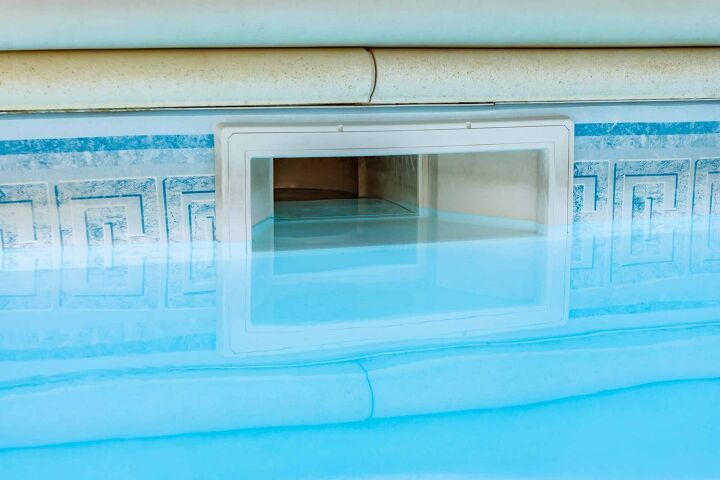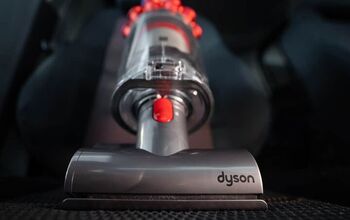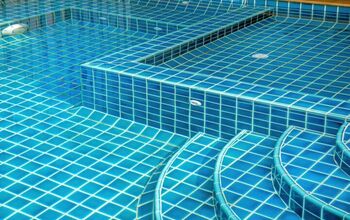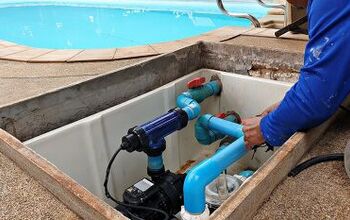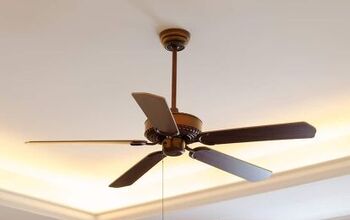Pool Skimmer Not Suctioning? (Possible Causes & Fixes)

Having a swimming pool is an excellent addition to just about any household. It allows you to kick back and relax on beautiful summer days. Plus, swimming and water aerobics are fantastic ways to keep your body in tip-top shape.
When you have a swimming pool, you know about how much maintenance goes into keeping it running properly. Sometimes things come up that you might not know how to fix. One of the most common issues people face is their pool skimmer, not suctioning.
A pool skimmer may not be suctioning because of a clog. If the impeller gets plugged up then the water cannot rotate out of the impeller’s sides. This results in a decrease in suction. Once the clog is cleared up, it should rotate normally. If not, you may need to purchase a new pool skimmer.
Listen, I know having pool problems can be a pain that you don’t want to deal with. Thankfully, there are plenty of tips and tricks to tackle the issue head-on. After reading this guide, you’ll be equipped with the knowledge you need to get your pool back up and running in no time.
Do You a Need Pool, Spa, or Hot Tub Contractor?
Get free, zero-commitment quotes from pro contractors near you.

Pool Skimmer Not Getting Enough Suction
Later on, we’ll discuss what to do if you’re dealing with a clogged pipe or skimmer system. One thing I wanted to touch on that may be causing a lack of suction could be the water pressure. Below is a guide to help you get the water pressure to the levels it should be and increase suction power.
Steps to Get The Water Pressure to The Right Level
Step 1: Check For A Low Water Level
The water should be at a minimum, halfway up the skimmer door opening. If it’s too low, the pump will have issues priming, and the water pressure will automatically fall.
Step 2: Check for Clogs
Now, look at the strainer baskets and look for any clogging. In the next section, I go into detail about how to get rid of a clogged skimmer basket. It’s good to check the strainer basket as well to ensure there’s nothing blocking the water flow.
If you do find that the strainer basket is filled with debris, simply empty it and put it back.
Step 3: Check The Water Filter
Take a look at the water filter and check if it’s clogged. If it is, there will be a decrease in water flow from the filter, which actually results in an increase in pressure. Be sure you’re cleaning the filter regularly to prevent this from happening.
Step 4: Check for a Suction Leak
A suction leak at the pump could be causing a lack of suction as well. The pump lid has an o-ring that prevents leaks. If this is loose, air can be sucked into the system. This will then create back pressure, reducing the amount of suction your skimmers are able to do.
Step 5: Check The Features
Something pool owners may not think about is that too many features could be opened. This affects the water pressure and can lead to a low suctioning skimmer. If you have a fountain running at the same time as the pool and your sprinklers, it could be an overload.
Consider alternating between which features you’re using and when. If you like using all of these things at once, you could replace the motor in the pump with a more powerful option. Just be sure to check that the existing filters will support a larger pump.
How to Increase Suction in a Pool Skimmer
Your main goal is to find the problem and fix it if your pool skimmer isn’t getting enough suction. Thankfully, we now know that the leading cause is a clogging issue. Here’s what you can do to quickly increase the amount of suction your pool skimmer is giving off.
Check the Valve
The first thing you’ll want to do to get more suction is to check the valve. Here you’ll be looking for two things: blockages and air leaks. If one of the skimmers isn’t sucking, you’ll want to remove the basket from the skimmer.
With the basket visible, you’ll then be able to check if the flow control valve at the bottom of the skimmer is open. It should be almost closet, but there are some that have a valve that doesn’t obstruct the suction inlet.
Doing this helps to ensure that the non-return valve is working correctly. When one is blocked or installed poorly, it can decrease the amount of suction the skimmer is able to perform. If the valve is working great, the chances are that the pipe is plugged up by something.
How to Unclog a Pool Skimmer
Pool skimmers are great for keeping the water clean, but it can result in more than a dirty pool when they’re not working properly. If one of the skimmers is clogged, it can make it hard for the water to pass through the filter. Below is a step-by-step guide on how to unclog a pool skimmer.
Step 1: Find Which Skimmer Is Blocked
If you have multiple, this can take a while if you don’t know which one is causing the issue. Doing this step gives you easy access to the access hatch.
Some skimmers have a small plate underneath the filter that helps regulate the flow. You may want to check that that’s properly in place and working as well. Sometimes when that plate moves, it can clog the hose that’s connected to the pool pump.
Step 2: Check The Plate Under The Filter
If you don’t see that there’s anything wrong with the plate under the filter, it reassures you that a clog has formed and can likely be easily removed. Clogs can form due to excess amounts of waste like fallen leaves or even a small pool toy.
Step 3: Exert Pressure Into The Pipe
Now, exert pressure into the pipe in the opposite direction of the suction. To do this, you can connect a hose or air compressor to help remove the clog. It’s important that you know what you’re doing when using these tools, and keep in mind there are professionals who you can call.
Step 4: Give The System a Backwash
Another thing you can do is give the filtration system a backwash. This is a great step if you’ve removed the clog’s source and still can’t get proper suction. Backwashing should be done weekly, and if it hasn’t been done for a long time, it can cause a lot of issues.
Step 5: Check The Bottom of Your Pool
If you’re still having suction issues, take a look at the bottom of your pool. You’ll be looking for lots of course dirt. If you find any, remove as much of it as you can and restart the filtration.
Prevention
So, now that you’ve fixed the issue and have working pool skimmers again, how can you prevent this from happening again? Assuming that it was a clog that caused the issue, regular maintenance is your new best friend. Not to mention, it will be a good idea to install a butterfly gasket for the best suction.
The skimmers can suck in things like insects, animals, plant debris, twigs, and small pool toys. If you keep to a schedule and check the baskets, it will reduce the chance of a future clog. Depending on how many plants you have surrounding your pool, you may have to do this a few times a week.
If you have kids in the pool who play with small toys, check the baskets after each use of the swimming pool. This helps to ensure that any rubber ducky or little floatation devices didn’t get stuck in the baskets!
Do You a Need Pool, Spa, or Hot Tub Contractor?
Get free, zero-commitment quotes from pro contractors near you.

Related Questions
What PSI should the pool filter be at?
While it can vary depending on what pool and filter you’re working with, there is a general range. Most filter systems are designed to operate between five and 20 PSI. You can find out what exact numbers your pool should fall within by backwashing the filter, emptying the pump, and skimmer baskets.
Then start up the filter and once it’s reached a full head, check the pressure gauge reading. Consider writing this down to keep somewhere for if you need the numbers in the future.
Why does my pool vacuum have too much suction?
If you’re dealing with the opposite problem and have too much suction, it’s a reasonably easy fix. All you have to do is restrict one of the ball valves on the pressure side of the pump. The filter pressure will go up and flow through the system, decreasing the amount of suction.
How often should you backwash your pool?
This is another thing where the size of your pool plays a major part. In general, a swimming pool should be backwashed around once a week. Something else that can help you decide when it’s time to backwash your pool is to look at the pressure gauge. When it reads between eight and ten PSI, it’s time to get cleaning.

Kirstin is a passionate writer who loves helping people learn new things when it comes to home improvement. When she's not behind a keyboard, she enjoys DIY projects, crafts, spending time with her pets, and making videos. She hopes that with all she writes, someone is finding a solution to their home improvement needs.
More by Kirstin Harrington



